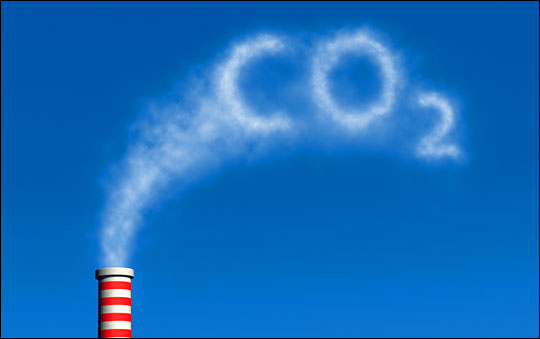Two years ago, the U.S. Supreme Court ruled that the EPA has the authority and the obligation to regulate greenhouse gases under the Clean Air Act. At a stroke, the politics of climate change were changed. The choice was no longer between legislation or no legislation — it was between legislation or regulation. One way or another, climate pollution would be controlled by a federal program.
Most experts agree that EPA regulations will be complex and somewhat unwieldy. Industry believes they will be onerous and expensive. Conventional wisdom, at least initially, was that fear of regulation would drive utilities and manufacturers to the bargaining table, changing the dynamic in Congress. EPA was supposed to play the role of the big, silent goon in the corner, tapping his baseball bat in his hand.
That theory isn’t holding up too well. Opposition from coal and manufacturing states weakened the bill in the House and its passage through the Senate appears less and less likely. Fossil fuel and other industry groups are lobbying furiously against it. The conservative base equates it with socialism. Democratic Senators are openly expressing skepticism whether a bill can pass this year. Health care may drag on into winter and push it off the agenda; it could fracture into smaller bills; most likely, it simply won’t find enough Blue Dog support to overcome a threatened conservative filibuster. At least at the moment, the smart money is on no climate/energy bill this year.
That means EPA regulations are suddenly germane again, though chances are high that 99.99% of Americans will continue to find the subject inscrutable and boring. What can the EPA do? When will it do it? Who will it do it to? How can we stay awake as we contemplate these matters?
Consider this post an effort to describe, in plain language, What the Deal Is with EPA Regulations. There will be acronyms … but also pictures of bunnies!
What’s everyone so scared of?
 Why does industry fear, and the Obama administration prefer to avoid, EPA regulations of greenhouse gases? To understand the political dynamic it helps to understand that there’s a three-part process … and the third part is a massive headache.
Why does industry fear, and the Obama administration prefer to avoid, EPA regulations of greenhouse gases? To understand the political dynamic it helps to understand that there’s a three-part process … and the third part is a massive headache.
1. Endangerment finding: A new air pollutant under the Clean Air Act first goes through an endangerment finding — a determination by the EPA whether it’s a threat to public health. For CO2, that’s almost done. EPA submitted the finding for public comment and is now reviewing the (many, many) comments it received. It will likely issue the final finding this month or next.
2. Mobile sources: If the EPA chooses to go forward, it then crafts regulations for “mobile sources,” i.e. vehicles, under Section 202 of the CAA. That won’t be too difficult. In effect, EPA will partner with the Dept. of Transportation to raise CAFE standards; they’ve already submitted a proposal to do so to the White House Office of Management and Budget. (35.5 miles per gallon by the 2016 model year.) So far so good.
3. Stationary sources: The problem is, once mobile sources are regulated, the EPA must, by law, also regulate stationary sources, i.e., power plants and industrial facilities. That is a serious can of worms, which will involve creative interpretations, contentious decisions, and many, many lawsuits. Why so difficult? We’ll get to that later, after a few more bunnies. First:
A little history
There’s a fascinating backstory to be told about Mass. v EPA, the 2007 Supreme Court case that shook the political world. But we’ll skip it. Instead let’s jump in just after it passed.
The Bush EPA wanted to move quickly. Bush had identified America’s addiction to oil in his State of the Union speech and proceeded to do very little about it, so there was some openness in the White House to conceding on a boost in CAFE standards. Since EPA regulation of mobile sources would effectively amount to just that, the Bushies were amenable to it.
To lead the large and capable team assembled to hash out the regulations (upwards of 100 people all told), EPA brought in Jason Burnett. Burnett is semi-famous to Grist readers for quitting the EPA in protest some months later, alleging interference from the Office of the Vice President. But initially, he says, “we were on a very fast clock. There was political desire to get everything done by the end of the administration’s time [in office].”
(See: full transcript of my wonky interview with Burnett.)
What changed? In short, Congress passed the Energy Independence & Security Act (EISA), “which did much of what we were planning on doing through regulations,” says Burnett. “After passage of the EISA, there was another way of accomplishing those same goals, and [the administration] didn’t then need to deal with the stationary source ramifications.”
At that point, things came to a crashing halt. Burnett sent the endangerment finding to the OMB, but the White House refused to open it. They told Burnett to take it back; he refused and left the agency. After that, the administration ran out the clock with endless public comment.
Obama came into office pledging to kick the process into gear, and he has. Lisa Jackson’s EPA has been hashing through the issues quickly. The final endangerment finding is coming soon, the mobile-source proposal is already on paper, and the stationary-source regulations … well, they’re another matter.
What’s so dang hard about stationary source regulations?
Grasping the challenges that greenhouse gases pose to the Clean Air Act means venturing into some fairly wonky territory; it is recommended that readers keep their bunnies with them at all times. Every effort will be made to minimize the … hey, you there, wake up!
 OK, the deal is, stationary sources of air pollution have to get a permit from the EPA. The permitting process is called New Source Review (NSR), implemented as part of the 1977 amendments to the Clean Air Act. All new sources have to go through this process.
OK, the deal is, stationary sources of air pollution have to get a permit from the EPA. The permitting process is called New Source Review (NSR), implemented as part of the 1977 amendments to the Clean Air Act. All new sources have to go through this process.
What about existing sources, the ones already up and running in 1977? In particular, what about the large U.S. fleet of old, inefficient, filthy pulverized coal power plants built in the ’40s, ’50s, and ’60s? Funny you should ask. Therein lies the problem(s).
Existing sources were not brought under NSR. They were “grandfathered,” in the lingo. Enviros consider this a deal with the devil, the Original Sin of the CAA. See: Carl Pope.
Congress didn’t completely ignore existing sources, though. NSR also specifies that any existing facility that makes “major modifications” that produce a “significant increase” in air pollution must get a permit.
How much is a significant increase? That’s defined by a standard called Prevention of Significant Deterioration (PSD). What must facilities in attainment areas (long story, let’s not bother) do to get a permit? They must install what’s called Best Available Control Technology (BACT).
NSR! PSD! BACT! Can you feel the electricity in the room? Let’s take a short bunny break …

Anyway, this kludged-together NSR/PSD/BACT policy created all sorts of problems and has been the subject of endless lawsuits. And here’s the thing: Many of the problems will be exacerbated by the extension of the Clean Air Act to cover greenhouse gases.
For instance: the PSD standard is now 100 tons for some facilities, 250 tons for others. Problem is, while 100 tons is a significant amount of most traditional air pollutants, it’s a reasonably meager amount of CO2. A coal power plant producing 10 or 20 million tons of CO2 a year could trip the PSD trigger merely by running a few extra minutes a year. “The scare story,” says Burnett, “is that that will cause facility managers for any large source of pollution to just freeze up and not make any modifications at all.” The problem, he says, is that “these large emitters just emit so, so much CO2.”
More troublesome: once you get down to 100 tons you’re talking about churches, schools, and retirement homes. This is the conservative nightmare scenario, that EPA’s regulatory reach will cover the entire economy and it will be red tape hell for every mom-and-pop operation.
Another problem is BACT itself. What is the best available technology for controlling CO2 emissions from, say, a coal power plant? Is it simply burning coal more efficiently? Cofiring with biomass or solar? Using carbon capture and storage, which is not yet commercially available? ‘Tis vexing. EPA will be breaking new ground, setting new precedents. Lawsuits will follow.
PSD solution … sort of
 As we speak, EPA is trying to solve the PSD problem by raising the threshold from 250 tons to 25,000 tons (it has submitted such a rule to OMB). This is in line with the new mandatory greenhouse gas reporting rule it proposed in March, which only applies to facilities emitting over 25,000 tons of CO2 a year.
As we speak, EPA is trying to solve the PSD problem by raising the threshold from 250 tons to 25,000 tons (it has submitted such a rule to OMB). This is in line with the new mandatory greenhouse gas reporting rule it proposed in March, which only applies to facilities emitting over 25,000 tons of CO2 a year.
Raising the threshold to 25,000 tons would exempt schools, churches, etc. — overall it would cover about 13,000 large industrial facilities, which represent 85-90% of U.S. emissions. So it would solve one of the biggest problems. Recall, however, that conservatives and (some) industries want EPA rules to be a regulatory/legal nightmare, and will do everything they can to insure that outcome.
Since raising the threshold would reduce the friction, some conservatives, like the Competitive Enterprise Institute’s Marlo Lewis, are arguing that it is illegal for EPA to unilaterally change the threshold. The rule, if it goes into effect, will undoubtedly be litigated to a fare-thee-well.
(Note: Congress could pass a one-line amendment to the Clean Air Act: “PSD for CO2 is 25,000 tons.” Boom, problem solved. If the climate bill goes down in flames and the EPA’s threshold rule is rejected, this is a easy face-saving move for Dems.)
The EPA might also try to express the greenhouse gas threshold with reference to a more potent gas like methane — the standard could be “250 tons of methane or methane-equivalent,” which would be lots of CO2. Even if the court rules against EPA, it might allow the agency to start at 25,000 and ratchet down to 250 on a schedule. There are also ways the EPA could make permitting for small sources relatively painless (think: a post card), but getting into more detail on this just feels anti-bunny.
BACT solution … not really
BACT is determined on a case-by-case basis. Whatever rulings the EPA makes, the precedent-setters, will be litigated to high heaven. There will be blood.
Cap and trade?
Another way forward, which some say could reduce compliance costs, is for the EPA to set up its own cap-and-trade program for stationary sources.
There’s a checkered history here. During Burnett’s original spin through EPA, he was involved in trying to develop a cap-and-trade system for mercury. Industry supported it but environmentalists loathed it, mainly due to concern over mercury “hot spots” (there are no such concerns for CO2). The courts ultimately ruled against that program; the Bush administration appealed; Obama’s EPA is going to drop the appeal.
But Burnett still thinks it can be done:
You dust off the legal argument EPA made for using [the CAA] for a cap-and-trade system, and you search and replace mercury with CO2. You’d put both environmental groups and industry in an awkward position. Environmental groups would want to support the rule, presumably. Industry would not want to, but they’re already on record saying EPA has authority to issue a cap-and-trade system under [CAA Section] 111. They wanted to have that for mercury.
Interestingly, an EPA-run cap-and-trade system would not have the same federal mandates as a legislative system. Instead it would effectively set out overall targets and allow states to figure out how to meet those targets. For states already covered by regional cap-and-trade systems — RGGI in the Northeast, MGGA in the Midwest, and WCI in the West — that would probably mean relatively minor tweaks in their existing systems. For all other states, it would mean linking into one of those systems or developing a new one.
Some folks, like Terry Tamminen, are advocates of this bottom-up approach, saying that it’s better to allow for regional variation and experimentation than get locked into a weak federal program. As yet, EPA hasn’t shown any indication that it will pursue this route, but it could still happen.
Political implications
 So how will all this play politically?
So how will all this play politically?
Conventional wisdom was that the threat of EPA regulations would make carbon-intensive industry amenable to a climate bill. But after seeing what passed the House, they’ve largely decided that they would rather have “the uncertainty of the Clean Air Act than the absolute certainty of a very expensive [legislative] program,” says Jeffrey Holmstead of Bracewell-Giuliani, who served at EPA under the second President Bush. Among those in heavy industry and the non-nuclear power sector, “it is nearly a universally held view that they’re better off just living with the CAA than they are having to deal with something like Waxman-Markey,” say Holmstead.
That’s not to say those industries will accept EPA regulations gracefully. Just as coal and oil have waged war against the climate bill, they’ll wage war on EPA regulations. They will sue as often as possible, at each stage. Already the Chamber of Commerce has announced its intent to sue against the vehicle regulations — and those, remember, had been hashed out with automakers beforehand. They were supposed to be the easy part.
The war against EPA regulations will also be waged with aggressive public relations campaigns. There will be great hue and cry about the economy-destroying burden that command-and-control regulations impose on American business. And unlike with a climate bill, responsibility (read: blame) cannot be dispersed. There is no hint of bipartisanship. Responsibility for EPA regulations will fall entirely on Barack Obama and his administration, not on Congress — which is probably how Congress prefers it. If it’s a total mess, or demagogued as one (as is all but certain), it’s Obama that takes the hit. That is yet another reason he’d rather avoid it.
Greens are fighting to preserve EPA authority in the climate bill. Some have even said that it would be preferable for legislation to fail and the EPA to take over. It’s not hard to understand why — something needs to be done about existing coal plants, and there aren’t many tools in the climate bill toolbox to address them. But no one should be under any illusions. The NSR/PSD/BACT approach is grossly suboptimal for the job that needs doing. It might have the intended effect — killing coal plants — but there’s potential for unintended effects as well, including substantial political blowback.
 Both sides, greens and industry, have reason to fear if the climate bill fails. It’s terra incognita, a volatile and unpredictable situation. Obama doesn’t need any more problems like that. That’s among the reasons he is likely, this fall, to put some of the time and energy toward lobbying for a good climate bill. From his narrow political perspective, virtually any bill is preferable to catching the EPA tiger by the tail. That tiger eats bunnies.
Both sides, greens and industry, have reason to fear if the climate bill fails. It’s terra incognita, a volatile and unpredictable situation. Obama doesn’t need any more problems like that. That’s among the reasons he is likely, this fall, to put some of the time and energy toward lobbying for a good climate bill. From his narrow political perspective, virtually any bill is preferable to catching the EPA tiger by the tail. That tiger eats bunnies.


